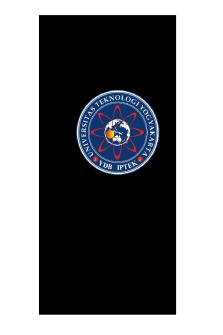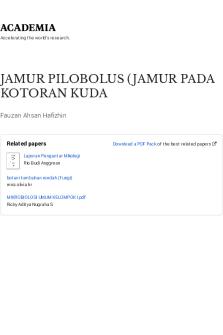Assignment (1) kuda kepang PDF

| Title | Assignment (1) kuda kepang |
|---|---|
| Author | A++ Student THC |
| Course | Labour Law |
| Institution | Multimedia University |
| Pages | 4 |
| File Size | 133.3 KB |
| File Type | |
| Total Downloads | 4 |
| Total Views | 155 |
Summary
nice review from google...
Description
Kuda Kepang Kuda Kepang is a traditional Javanese dance which originates from Java, and was later brought to Malaysia by Javanese immigrants.1 Due to the passing of time, Kuda Kepang serves both the secular and ritualistic functions. Nowadays, it serves more of a secular function but in the old days, the dance served its ritualistic function when it was performed to cleanse villages of evil spirits. Such custom has become a norm in Malaysia, especially in the state of Johor. Thus, without a doubt, Kuda Kepang falls within the definition of urf as it is a customary practice. Kuda Kepang is actually practical urf (fi’li), for the sole reason that it involves a practice and performance, and not just a saying. However, just because Kuda Kepang is a customary practice, does not make it valid, as it needs to fulfil the conditions of urf. For the first condition of having to be a recurrent phenomenon, Kuda Kepang, is not practiced by majority of Malaysians and it is only prevalent in one particular locality, which is the state of Johor. This makes Kuda Kepang an al-urf al-khass, which means a custom specially for a particular group of people or locality. Although the majority of the scholars are of the opinion that the custom must be practiced by majority for it to be accepted as valid, there are opinions of some Hanafi jurist who have held that special urf shall still be considered as valid. Nevertheless, since Malaysia follows the Shafie school of thought, it is clear that since Kuda Kepang does not fulfil this condition. The second condition Kuda Kepang needs to fulfil is to be a dominant custom. For it to be dominant, it has to be well recognised. This customary performance takes place for most ceremonial occasions in Johor. It has also been displayed in many cultural programmes with the help of PUSAKA, a cultural organisation, who has worked closely with the Kumpulan Kuda Kepang Parit Raja, in order for the latter to partake in these programmes.2 Thus, by performing in these programmes, Kuda Kepang has become well recognised and thus, fulfils the condition of being a dominant custom. Another condition is that Kuda Kepang must not violate any primary sources of Syariah. To determine whether Kuda Kepang violates any nass, it is pertinent to note the steps taken in such performance. In a study conducted on Kuda Kepang in a village of Parit 1 'Kuda Kepang' (The Star Online, 2011) accessed 28 August 2020. 2 'Communities - Kuda Kepang — PUSAKA' (PUSAKA) accessed 28 August 2020.
1
Nipah Darat, it was found that the performance starts off with the Shaman performing a ritual over the hobbyhorse figures as he smokes them in the benzoin smoke to invoke spirits to possess the dancers. Each dancer then takes a hobbyhorse figure and enters a trance state. Entering this trance state, evokes a euphoric or ‘high’ feeling to the dancer, which can be addictive. After the dance stops, the Shaman exorcises the spirits from the dancers by pressing his thumb and the dancer’s naval and recites a prayer to release the spirit.3 Now, we shall consider this performance in segments. For the first part, where the Shaman recites a ritual to invoke spirits to possess the dancers, this is clearly prohibited under Al-Quran (10:106) which states “And do not invoke besides Allah…for if you did, then indeed you would be of the wrongdoers.” The word ‘invoke’ refers to the calling upon spirits and thus, can cover the act done by the Shaman. Furthermore, the phrase ‘you would be of the wrongdoers’ spells out clearly that such act is forbidden. In the hadith reported by Sahih al-Bukhari4, it states that "Seventy thousand people of my followers will enter Paradise without accounts, and they are those who do not practice Ar-Ruqya …and put their trust in their Lord." The term ‘Ar-Ruqya’ refers to the invoking of spirits and Jinns and thus, those who practice it shall not enter Paradise. The second segment of such performance refers to the trance state which the dancers enter. Based on the study, it gives the dancers the feeling of ‘high’ and it is so addictive that some dancers would want to return to such state immediately. We can clearly use analogical reasoning by referring to Al-Quran (5:90) which provides that “intoxicants are the work of Satan, so stay away from it.” Such old case has the same effective cause as the new case which is the intoxicating effect which evokes the feeling of high. Thus, since the ruling of the old case is haram or prohibited, therefore, the same goes for the new case, which is entering the trance state by performing Kuda Kepang. It should be noted that such analogical reasoning and explanation was done by Johor State Mufti Department which led them to issue a ruling or fatwa, on the 18 th of February 2009, to ban or forbid Kuda Kepang performance in Johor.5 Another aspect pointed out by the fatwa was that such performance was based on superstitions and black magic and thus, it 3 Mohamed Ghouse Nasuruddin and Solehah Ishak, 'Healing Through Trance: Case Study Of A Kuda Kepang Performance In Batu Pahat, Johor' (2015) 185 Procedia - Social and Behavioral Sciences. 4 Sahih al-Bukhari Volume 8, Book 76, Number 479 5 (E-smaf.islam.gov.my, 2009) accessed 28 August 2020.
2
may cause Muslims to divert away from the right path. This can be supported with AlQuran (17:56) which states “Say, "Invoke those you have claimed [as gods] besides Him, for they do not possess the [ability for] removal of adversity from you or [for its] transfer [to someone else]." Thus, this verse highlights that even if one uses superstitions or black magic, they cannot help him as only Allah s.w.t can be help to remove his troubles. Therefore, although Kuda Kepang is an urf, it is not valid nor is it authoritative since it fails to meet the conditions of being practiced by majority of Malaysians and it also violates both the Quran and the Sunnah. However, in recent times, the Kuda Kepang custom is still being performed regardless of the ban issued by the fatwa. The reason for this is because such fatwa was never gazetted and also there has been a change in function of such performance. According to Mohd Yazid from ‘Kumpulan Warisan Seni Sri Johor’, such customary performance is now free from aspects of exorcism and being in trance state.6 Thus, if we take this development into consideration, Kuda Kepang no longer violates any nass, and thus, fulfils the third condition. Furthermore, with regards to being a recurring phenomenon, there is no doubt that such customary practice is slowly becoming common through various programmes like the George Town Festival 20147 and more recently the ‘Urbanscapes 2019: HuRu-HaRa’ program.8 This led to Kuda Kepang to not only be popular in Johor, but it is now known throughout Malaysia. However, it is still not being practiced by majority of Malaysians who are either unaware or are not concerned with such traditional custom. In summary, although Kuda Kepang, falls within the definition of urf, it still does not meet all of the conditions for a valid urf. Nevertheless, there is a possibility that in the future, as such customary practice becomes more recognised, more people would practice it and therefore it will become a valid urf in Malaysia. Bibliography
Sahih al-Bukhari Volume 8, Book 76, Number 479
6 Azrul Sobry and Mohd Parzi, 'Kuda Kepang Dah 'Jinak' (BH Online, 2015) accessed 28 August 2020. 7 Cheryl Hoffmann, 'The Beat Of Our Souls: Kuda Kepang And The Spiritual Self' (The beat of our souls: Kuda Kepang and the spiritual self,2014) accessed 28 August 2020. 8 Robert Holst, 'Urbanscapes 2019: Huru-Hara - Kuda Kepang' (KL100, 2019) accessed 28 August 2020.
3
Al-Quran (5:90)
Al-Quran (10:106)
Al-Quran (17:56)
(E-smaf.islam.gov.my, 2009) accessed 28 August 2020
'Communities - Kuda Kepang — PUSAKA' (PUSAKA) accessed 28 August 2020
Hoffmann C, 'The Beat Of Our Souls: Kuda Kepang And The Spiritual Self' (The beat of our souls: Kuda Kepang and the spiritual self,, 2014) accessed 28 August 2020
Holst R, 'Urbanscapes 2019: Huru-Hara - Kuda Kepang' (KL100, 2019)
accessed 28 August 2020
'Kuda Kepang' (The Star Online, 2011) accessed 28 August 2020
Nasuruddin M, and Ishak S, 'Healing Through Trance: Case Study Of A Kuda Kepang Performance In Batu Pahat, Johor' (2015) 185 Procedia - Social and Behavioral Sciences
Sobry A, and Parzi M, 'Kuda Kepang Dah 'Jinak' (BH Online, 2015) accessed 28 August 2020
4...
Similar Free PDFs

Assignment (1) kuda kepang
- 4 Pages

Tutorial SAP2000 kuda-kuda baja
- 53 Pages

Perrhitungan Kuda-kuda Rangka Baja
- 17 Pages

EVOLUSI KUDA
- 1 Pages

Makalah Sistem Pencernaan Kuda
- 1 Pages

Pemeriksaan Klinis pada Kuda
- 12 Pages
Popular Institutions
- Tinajero National High School - Annex
- Politeknik Caltex Riau
- Yokohama City University
- SGT University
- University of Al-Qadisiyah
- Divine Word College of Vigan
- Techniek College Rotterdam
- Universidade de Santiago
- Universiti Teknologi MARA Cawangan Johor Kampus Pasir Gudang
- Poltekkes Kemenkes Yogyakarta
- Baguio City National High School
- Colegio san marcos
- preparatoria uno
- Centro de Bachillerato Tecnológico Industrial y de Servicios No. 107
- Dalian Maritime University
- Quang Trung Secondary School
- Colegio Tecnológico en Informática
- Corporación Regional de Educación Superior
- Grupo CEDVA
- Dar Al Uloom University
- Centro de Estudios Preuniversitarios de la Universidad Nacional de Ingeniería
- 上智大学
- Aakash International School, Nuna Majara
- San Felipe Neri Catholic School
- Kang Chiao International School - New Taipei City
- Misamis Occidental National High School
- Institución Educativa Escuela Normal Juan Ladrilleros
- Kolehiyo ng Pantukan
- Batanes State College
- Instituto Continental
- Sekolah Menengah Kejuruan Kesehatan Kaltara (Tarakan)
- Colegio de La Inmaculada Concepcion - Cebu









